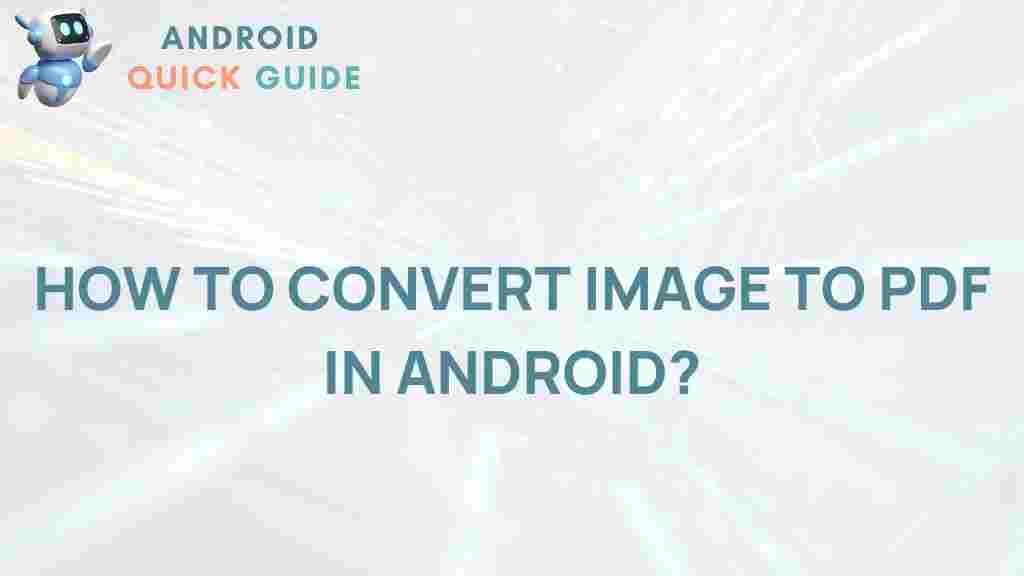Unveiling the Secret: Transforming Images into PDFs on Android
In the digital age, converting images to PDF format has become a necessary skill, especially for those using Android devices. Whether you want to share documents, preserve important images, or create professional portfolios, knowing how to convert images to PDFs on Android is essential. This article will guide you through the process, offering tips and troubleshooting advice to ensure a smooth experience.
Why Convert Images to PDF on Android?
Before diving into the steps, let’s explore why you might want to convert images to PDF on your Android device:
- Compatibility: PDF is a universally accepted format that can be opened on any device.
- Preservation of Quality: PDFs maintain the quality of images better than other formats.
- Security: You can protect PDFs with passwords, ensuring sensitive information remains secure.
- Ease of Sharing: PDFs are easier to share and print than individual images.
How to Convert Images to PDF on Android
Converting images to PDF on Android can be done in several ways. Below, we outline the most common methods:
Method 1: Using Google Drive
Google Drive is a powerful tool that not only stores your files but also helps you convert images to PDF. Here’s how:
- Open the Google Drive app on your Android device.
- Tap the + (plus) icon to upload your images.
- Select Upload > Photos and Videos.
- Choose the images you want to convert and tap Upload.
- Once uploaded, select the image file in Google Drive.
- Tap on the three dots in the upper right corner and select Print.
- In the printer selection, choose Save as PDF.
- Tap Save, then choose a location to save your PDF file.
Method 2: Using a PDF Converter App
There are numerous apps available on the Google Play Store specifically designed for converting images to PDFs. Here are some popular options:
- CamScanner: A powerful scanning app that converts images to PDFs with excellent features.
- Image to PDF Converter: A straightforward app focusing on image-to-PDF conversions.
- PDF Converter: An all-in-one converter supporting various file formats.
To use an app like CamScanner:
- Download and install CamScanner from the Google Play Store.
- Open the app and tap the Camera icon to scan a new image or Gallery to choose existing images.
- Select the images you want to convert and tap Next.
- Adjust the crop if necessary and tap Next.
- Choose PDF as the format and tap Save.
Method 3: Using Online Converters
If you prefer not to install any apps, online converters are a great option. Here’s how to use them:
- Open your web browser and search for online image to PDF converter.
- Visit a reputable site like iLovePDF.
- Upload your images by dragging and dropping them or using the upload button.
- Adjust settings if necessary (like orientation or margins).
- Click Convert to PDF.
- Download your converted PDF file.
Troubleshooting Tips
Sometimes, issues may arise during the conversion process. Here are some common problems and their solutions:
- Slow Conversion: Ensure a stable internet connection if using online tools.
- File Size Too Large: Try compressing your images before conversion.
- App Crashes: Make sure the app is updated to the latest version. Restart the app or your device if necessary.
- Quality Loss: Check the settings in the app or tool to maintain high-quality outputs.
Conclusion
Converting images to PDF on Android is an essential skill that can enhance your productivity and streamline your document management. Whether you choose to use Google Drive, a dedicated app, or an online converter, the process is straightforward and efficient. By following the methods outlined in this article, you’ll be able to transform your images into PDFs with ease. Don’t hesitate to explore different tools and find the one that best fits your needs!
For more tips and resources on using Android effectively, visit our Android resources page.
This article is in the category Guides & Tutorials and created by AndroidQuickGuide Team
